How to View a Family Tree on 23andme
The 23andMe family tree characteristic was introduced in 2019, and is very different from a traditional genealogy tree.
What is a 23andMe Family Tree?
A 23andMe family tree is a graphical representation of the potential relationships between you and your Dna relatives. If you opt in, 23andMe calculates your genetic tree.
If Ancestry'southward tree software is known for the green leafage icon, then 23andMe may become known for their wavy lines. Here's an excerpt of a tree which has been edited past the DNA tester:
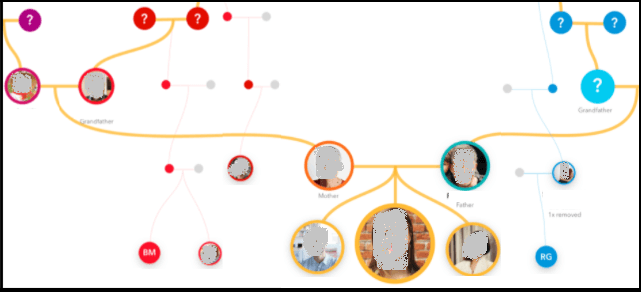
The thick golden lines represent direct pedigree relationships: parents, grandparents, and so forth. The thinner lines represent collateral lines within your tree: the descendants of your swell-aunts, for example.
Unlike traditional family unit tree software, the entire representation is displayed on a unmarried page. You will likely demand to zoom in and out to work with particular areas.
How Does the 23andMe Family Tree Work?
The 23andMe tree is created by an algorithm that analyses how much Deoxyribonucleic acid is shared between you and a set of your DNA relatives. 23andMe has not divulged much technical detail, but I will infer some broader aspects of the process. This is my take on a high-level breakdown of how your family tree is generated.
The algorithm chooses 1 or more of your Deoxyribonucleic acid matches to work with. How does information technology cull which ones? I'll address that in a later section. For now, we'll work through an example with Mary, Bob, and Joe.
Let'south say that yous share twenty% of DNA with Mary, a DNA relative that y'all haven't figured out yet. That'due south just shy of 1500 centimorgans. Yes, this is a lot of Deoxyribonucleic acid, but it's easier to work this through with a more obvious relationship.
When you lot await at Mary's listing of Relatives in Common, yous come across Bob at the acme of the listing. Bob shares 9% of Dna with you lot, and 49% with Mary.
Joe shares 23% of DNA with y'all but is non on the Relatives in Common lists of Mary or Bob.
Stride 1: Cluster the chosen DNA relatives
I assume that the 23andMe algorithm arranges the chosen Deoxyribonucleic acid relatives into groups of overlapping shared DNA. Here is a crude cluster diagram of Mary, Bob, and Joe:
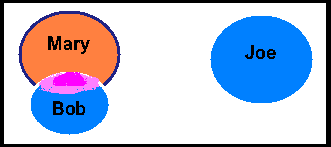
Stride 2: Predict the Possible Genetic Relationships
The side by side step is to draw up a list of the possible genetic relationships between your and the three Dna relatives, and then between themselves. 23andMe gives us the pct of shared DNA, so we can as well practice this ourselves.
If you share 20% of Dna with Mary, then these are the more probable relationships: grandmother, aunt, one-half-sis, niece, or granddaughter. There are also some other relationships that are less statistically possible.
Similarly, Joe is likely to be your grandad, uncle, nephew, half-blood brother, or grandson.
Bob is more challenging. There are 13 relationships of similar likelihood – including those caput-scratchers similar half start cousin and half dandy-uncle. Allow's lay information technology all out like below. The reason for the alignment will become clear.
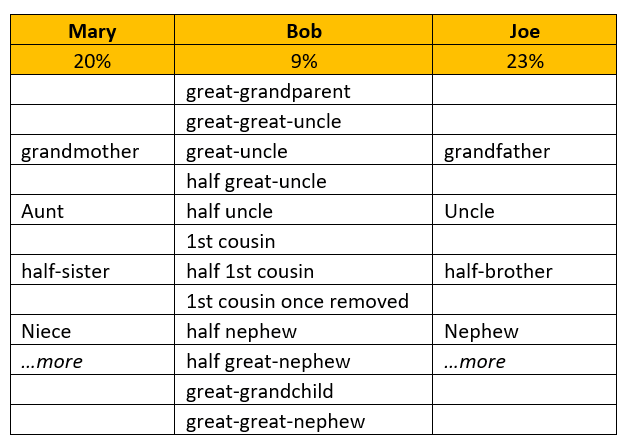
Now let's consider the possible relationships between them. 23andMe knows that Bob shares 49% of Dna with Mary. So, Bob is either Mary'due south male parent or her son.
Joe has no matches with either Mary or Bob, so we tin can safely say that he does non share a grandparent with either of them. But we couldn't say, for instance, that this is a paternal/maternal divide for you. Joe could share great-groovy grandparents with Mary, and still not have inherited any shared segments of DNA.
Stride three: Filter the possible relationships based on other factors
Which is it, Bob? Are you Mary's father or her son? Nosotros can't tell based on the genetic data, but 23andMe has admission to more information. For case, 23andMe knows its customers' dates of birth.
Allow's say you are 50 years of age, Bob is 25, and Mary is 48. Oh, and Joe is the most senior at 72.
Wherever 23andMe slots Mary into your genetic tree, Bob will exist placed beneath her as her son.
Yous and Mary are of similar age, then they can strike a line through grandmother.
Theoretically, they can't dominion out the 72-yr-one-time Joe as your nephew – but information technology would be a highly unusual age-gap.
We're now into genealogical statistics. The table higher up is aligned horizontally with the more likely groupings of age. Each possibility tin can be allocated a score based on historic period-range.
Are in that location factors other than age? The documentation mentions the pattern of shared DNA segments, and of relatives in common. It would be interesting to know the weighting assigned to these factors, but that's non publicly available.
Step 4: Generate a unmarried tree that represents the well-nigh likely possibilities
Crisis the numbers, tot upward the possibility scores, pick a winner…and boom! Your single 23andMe family tree with i or more of your Dna relatives slotted into their theoretical places.
It'south an impressive fusion of genetics, statistics, and visualization.
If y'all're an old-manus at investigating your genetic relationships, you may be thinking – but this is what I practice with tools like the Shared CM Project at the DNA Painter website.
Well, exactly. The underlying techniques are not new. Just I bet you lot don't choose to exercise this blindly, with no reference to your known family relationships. Unless you lot are in a position of unknown parentage, you volition add together factors to your investigation such equally ancestral surnames and place names.
23andMe does not comprise traditional family trees that customers may accept linked in their profiles. I don't think they brand apply of the list of bequeathed surnames that so few of my DNA relatives fill out.
This family unit tree is based entirely on Dna and statistics. Which is impressive. Simply is it useful?
Working on Your 23andMe Family Tree
23andMe emphasizes that they aim to give yous a head start when edifice your family tree. So, they slot in 1 ore more of your genetic relatives – along with a whole lot of placeholders that yous need to fill in yourself.
Here'due south a pic of my genetic tree, untouched by (my) man hands:
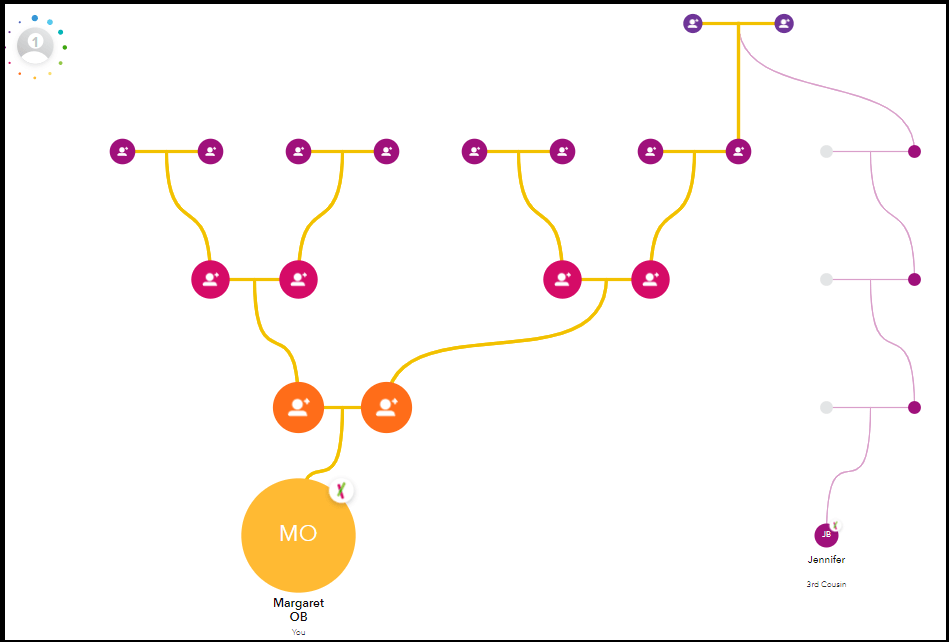
You don't need to squint. I'll tell y'all that they slotted in ONE of my Dna relatives. Simply the 1.
This is where the marketing message doesn't quite fit reality, at least for me. This is the sales pitch:
"Building a family tree from scratch tin can exist time-consuming and overwhelming. 23andMe makes information technology easier by automatically generating a family unit tree for you."
They have, in fact, generated a load of placeholders. With an estimated 3rd cousin, I must fill in at least seven of the placeholders to establish the relationship.
To be fair, this 3rd cousin is my highest Deoxyribonucleic acid relative on 23andMe. I know that many customers will take enough of relatives within the range of twond cousin on the website. I presume that their starting trees are a flake less sparse at the everyman level.
Regardless, at that place are placeholders that won't fill in themselves! And then, let'southward become to it.
Calculation Family Members to Your 23andMe Family unit Tree
The first affair to do is to add a parent. I know my single Deoxyribonucleic acid relative is on my maternal side, due to an ethnic comparison – only I don't know anything else! So, I started by adding my mother.
In traditional genealogy trees, the paternal side is visually on the left. 23andMe says pshaw to your traditions – might exist left, might not exist. The reason is that they are not deducing whether your matches or maternal or paternal unless you've tested either parent.
I think its chance that my match is to the right of the screen, but that's okay with me.
The starting time fourth dimension you enter a relative, you are required to read a short privacy statement.
Information you enter about living relatives volition be visible only to you lot. Any information you enter about deceased relatives will be displayed to your Deoxyribonucleic acid relatives and connections.
I've bolded the second sentence. Information technology has considerable consequences, which I'll accost in the section on Privacy. It also isn't true at the time of writing in 2020 – I tin can't see the copse of my DNA relatives. I presume this is "coming presently".
I'm non sure if the adjacent question would announced if I had tested a parent: is this paternal or maternal?
Dod you notice how there is a uniform color scheme across both sides of my initial tree? At this indicate, 23andMe volition start differentiating areas of the tree by colour.
Entering Names, Dates, and Gender in a 23andMe Tree
23andMe looks for limited information about each person. For case, there is only input for nascency and death dates and locations.
I respect the attempt at gender-inclusivity, but I retrieve the designers take made a bit of a hash of it. They simply provide ii choices (male or female person), with the info popular-up telling the states that picking either is optional. But if you pick female person and want to revert to an undefined condition…you can't. I think yous have to delete the unabridged entry and kickoff once again.
Current Tree Limits
At the fourth dimension of writing in late 2020, there are some limits of entry into the family unit tree.
I've seen mention of a limit of 250 people in forums, but I haven't tested this (with manual entry? No, thanks!)
But I did exam the number of generations you lot could go back. The beta version may take had a limit, but I found that 23andMe currently doesn't end you from adding circles above circles. However, it stops naming the generations after "fivethursday-great-grandfather". Prior generations are named "Distant Antecedent".
23andMe's lack of involvement in generations before 5th nifty-great is understandable. At that point, you lot are inheriting less than 1% of the antecedent's DNA. Therefore, the information is not useful for the genetic tree.
Endogamy (cousin marriages) is non recognized
You cannot add together a relationship betwixt individuals across paternal and maternal branches. As 23andMe puts information technology in their FAQ: your dad's parents were second cousins? Computer says no! (I'm paraphrasing a little).
They're going to accept to address this considering low levels of endogamy are mutual. The documentation says it's not "currently" possible, and then I imagine information technology's on the roadmap.
Can You Import a Family Tree?
No, you lot tin can't import or majority upload details to your family tree.
What's that? Yous've got a family tree elsewhere? Doesn't affair. Y'all have to type information technology in again.
23andMe does not offer the ability to import a GEDCOM file, for instance. Or transfer information from the copse you lot link to in your profile. Or do anything with those bequeathed surnames you listed in your account profile.
As I was inbound my grandmother's place of nascence, I was request myself: oasis't I given them this already? Why, yep. Yep, I had. Your 23andMe enhanced profile looks for your grandparents' birth locations:
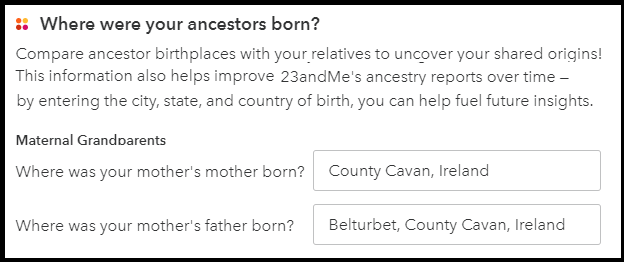
Then, my typing up my family tree was accompanied past some grinding of teeth.
Can You Export or Share your 23andMe Family Tree?
Ancestry and MyHeritage are ii Dna testing companies that allow you to maintain your family trees online. Both offering the facility to download your trees to a standard format, known every bit a GEDCOM file. They besides permit you grant permission to other people to view your online family tree (without a paid subscription).
In contrast, 23andMe does non offer the ability to export or download your family tree. Nor tin can you share your tree with others.
The just piece of work-effectually I tin can find is to take a screen-capture of your zoomed-out tree. The problem is that names and other text are very tiny when yous're capturing a total tree.
Which DNA Relatives Are Automatically Added to Your Tree?
You can't choose which of your DNA relatives are automatically added to your 23andMe family tree. These are chosen for you by the algorithm. Merely which matches are called? And what criteria is used to pick some and not others?
I'grand merely asking for a friend…
Nah, I'm selfishly asking for myself. With one solitary DNA relative in my tree, I took a long expect at the documentation to see if I could somehow trigger some other arrival. This is all I got:
To kick-start your tree, 23andMe looks at your closest twenty DNA relatives and predicts their relationships to each other. After this initial tree prediction, new [] 2nd cousins and closer volition prove up in your unplaced relatives list.
Well, I tin can tell you that the above statement in the FAQ is not strictly true. My single added relative is my highest shared match and is estimated as a iiird cousin. There is ane additional Dna relative in my "unplaced relatives" listing. This 2d lady shares even less Deoxyribonucleic acid with me and is estimated as fourth cousin.
I'm wondering if this is the marketing department twisting the arms of the engineers. Information technology reminds me of 23andMe's big rival, Beginnings, rolling out a major new characteristic – to be greeted by disappointment from those who didn't reap any benefit. (I'm thinking of Dna circles. I never got a single 1).
Am I getting a few breadcrumbs, and then I don't feel left out? More chiefly… is there a fashion to trigger some new DNA additions?
How Do You Go Deoxyribonucleic acid Relatives Calculated Into Your Tree?
There are two obvious answers here. The first is to have patience and wait for newer closer relatives to turn up on 23andMe. The 2d is to conform for closer relatives to test with 23andMe.
Another source of promise is that the algorithm improves in its interpretation of the genetic data to hand. Regarding the paternal vs maternal divide, perhaps the 23andMe algorithm can bring the Ten chromosome into play. Maybe some tweaks are still to come up.
Privacy and the 23andMe Family unit Tree
When you make your offset edit to your family tree, 23andMe requires you to confirm that you understand the privacy policy. This advises that living people will be private, but people marked as deceased in your tree will be visible to your opted-in DNA relatives. So, this is where 23andMe is going.
And this is in line with other major online family tree services. Beginnings and MyHeritage have similar policies for the default privacy options of their hosted trees. However, both these rivals to 23andMe give customers the option to brand their trees fully individual. Information technology'south non clear whether 23andMe will provide this option.
Research Copse
I desire to aid and collaborate with my Deoxyribonucleic acid relatives, so I maintain a public tree online on both Ancestry and MyHeritage.
However, I don't want to lead people astray when I'yard chasing speculative leads and experimenting with potential relationships with my genetic matches. My arroyo, which I learned from other hobbyists, is to put my speculation into private inquiry trees. When I've gathered enough genealogical show to back up the tree entries and relationships, I add them to my public tree.
My concern with my 23andMe family tree is that my actions in filling in the placeholders volition be conducted in public view of my Deoxyribonucleic acid relatives. I've sent this feedback to 23andMe via the family unit tree page. Hopefully, their privacy policy will get more sophisticated.
How Do You lot Recalculate Your 23andMe Family Tree?
This article required a chip of experimenting with my tree. For example, I entered eight fake generations on an unknown line to see how far dorsum information technology would go. So, I wanted to revert to factory settings, so to speak.
I'd seen mention of triggering a recalculation of the tree – but when I went looking for a big red reset push button…I couldn't notice information technology. Resorting to Google took me to the FAQ page, which had me completely confused. Until I realized that the recalculate feature is hidden within the FAQ section!
Expand the dropdown at the terminate of the section…

And you get to run into a big carmine reset push button:

You're welcome! Clicking the button gives yous an informational bulletin to await for ten-xv minutes for the tree to be recalculated.
When I refreshed my tree after ten minutes, I was excited to meet the display below. Where before I'd had one unplaced relative, I now had fifteen.

Did I now accept fourteen more DNA relatives added to the everyman level of the tree? No. These were fourteen entries that I had added when playing with the tree. 23andMe saves them here, if I need to put them back into the placeholders.
Rival Offerings
23andMe isn't the just DNA site that automates the generation of sections of your family tree based on proprietary algorithms. Ancestry has ThruLines, and MyHeritage has Theories of Family Relativity. Both these offerings use the family trees hosted on their sites to construct hypothetical lines.
The major divergence to 23andMe is that the latter doesn't use existing family unit tree information at all. Information technology'southward purely based on DNA and genetic possibilities.
The Historic Dance Partners of 23andMe
The corporate origins of 23andMe were not in genealogy and family history. It was founded in 2006 to provide consumer genetic testing with a focus on wellness. So, its family tree offerings have long seemed like a bit of an afterthought.
Over half of respondents to a survey by the company in 2020 said that they were interested in their family unit trees. I doubtfulness that is a recent phenomenon. So, what practise companies practice when customers want a feature outside their wheelhouse? Sometimes they gobble up some other company that already does that one thing meliorate. And sometimes they collaborate.
23andMe has twice chosen to collaborate. They started with MyHeritage.
23andMe and MyHeritage
23andMe had a rudimentary tree editor earlier 2015. But and then it partnered with MyHeritage, who are leading providers of online family tree services. 23andMe customers could now create a fairly small tree with access to MyHeritage record archives. In fact, 23andMe turned off its own tree editor. New testers had to use MyHeritage to create their trees.
There was a lot of noise nearly software and platform integration, and so the whole partnership was discontinued.
The Wild Years of Many Dance Partners
When I tested with 23andMe in 2017, the in-house genealogy offer was two-fold. These options are withal bachelor, past the way:
- Enter a list of bequeathed surnames in your account contour
- Take a whirl with one of many approved family tree "partners"
The first choice is kinda lame, but better than nothing.
The 2d option involves providing a web link to your family tree hosted elsewhere. This may not be a comprehensive list, but these are some of the possible websites that 23andMe would accept:
- Beginnings
- MyHeritage
- Geni
- FamilySearch
- Findmypast
- WikiTree
Some customers were irritated that they could merely choose one of the many sites where they kept their family copse. And had the bright idea of setting upwardly a web log folio with as many links as they wanted. Merely when they tried to signal their 23andMe accounts at the customized web pages, they realized there was an approved listing. Foiled!
My web link points at my Ancestry family unit tree. But it'southward a hurting in the neck for my 23andMe Deoxyribonucleic acid matches who don't also have an account with Ancestry. They would have to register for a (free) Beginnings account to view my tree. This was never an ideal implementation.
23andMe and FamilySearch
FamilySearch is a massive genealogical organization, operated by the LDS Church. 23andMe started a partnership with them in 2019. Customers were invited to "enhance your 23andMe contour with FamilySearch."
This involved either associating your existing tree on FamilySearch with your 23andMe account or creating a new attached tree on the external site.
This collaboration was nixed less than a year later. At this point yous gotta wonder – is it the partners of 23andMe who are at fault in these brief relationships? Or is 23andMe's track record non looking then nifty?
Just by this fourth dimension, that choice between build versus buy had been reversed. 23andMe had built the beta version of its own family tree offering.
GrandTree
The GrandTree feature has nothing to practise with the automated family tree service. Just for abyss, I'll touch upon it here.
This seems to be a little-mentioned tool tucked away in the recesses of 23andMe. If your grandparents take tested with 23andMe, this tool shows yous how much Dna you go from them. I tin't give a personal account on this one, every bit I do not accept a tested grandparent.
Having read some other accounts, I see that 23andMe correlates the Dna inheritance with their health and traits reports. This aspect of 23andMe isn't a draw for me, but here is the link for you lot to investigate.
Adoptees, Unknown Parentage, and the Genetic Tree
I've seen mention in forums that this feature could exist useful for people with unknown parentage. As 23andMe says, it provides a head start.
Permit's go back to my example of Mary, Bob, and Joe. If the tester were lucky enough to see these closer matches turn up in their family unit tree, it could exist helpful to go a visualization of Mary and Bob's human relationship being mother and son. Sure, an experienced researcher could work this out using diverse tools. But 23andMe is putting the results of these complex tools into the hands of a wider audience. Bravo!
Even so, the usefulness will depend on who has tested amidst the customer's genetic relatives. My unknown 3rd cousin dropped into my tree is not helpful. Now, if that person had an available family tree going back to her iind great grandparents, then that would be gold.
In that location isn't any sign that 23andMe is moving towards incorporating genealogical trees on their platform, which is a pity. I recommend that people seeking to resolve unknown parentage should choose the Ancestry Deoxyribonucleic acid kit – if they tin only affort to purchase one test. But both kits, and other Deoxyribonucleic acid sites, can be function of an overall strategy for researching genetic relatives. Bank check out our review of best DNA tests for adopted adults to unlock family heritage.
My Verdict – A Work in Progress
I took a wander around the social media forums to see if in that location was a general verdict every bit to the usefulness of this genetic tree. When 23andMe introduced the software in beta, there were a lot of teething bug with crazy results. Past and large, the major bug seem to have been ironed out.
Some customers are very happy with the feature. This weblog commenter gives a good summation of how it helps:
"The tree helps me sympathise cousin relationships and what it means in cM when someone is on one branch vs some other or nether unlike grandparents. Since I only can't call back all this, the tree helps me visualize these concepts."
At the other end of the spectrum, some people are irritated that 23andMe has moved even further away from genealogical inquiry through traditional family trees.
Then there'due south the heart ground that's pretty much: okay, it's cool, just what do we do with it?
One Redditor commented that he had put some effort into building out his tree by adding family members with names, dates, and locations. And he said:
"Simply afterwards I finished, I was left with asking myself what was the point of spending an hour entering data?"
I'm not sure that 23andMe has clearly demonstrated the benefits to its customers. Having said that, the company has put a considerable amount of development endeavour into this feature. Introduced in late 2019, information technology seems that 2020 was about eliminating the glitches and refining the process.
Personally, I'm very interested to come across the hereafter progress for the feature. And I've got my fingers crossed that a few more than Dna relatives driblet into my family unit tree.
Source: https://www.dataminingdna.com/your-calculated-23andme-family-tree-a-guide/
0 Response to "How to View a Family Tree on 23andme"
Postar um comentário